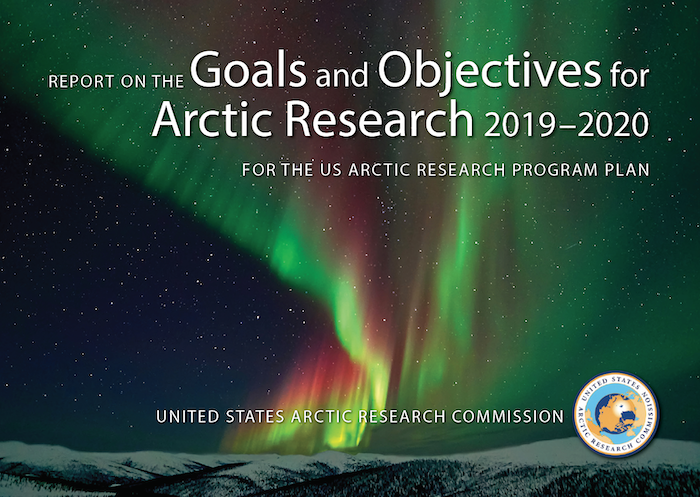By: Cheryl Rosa, U.S. Arctic Research Commission Deputy Director
The U.S. Arctic Research Commission (USARC) released their 2019-2020 Report on the Goals and Objectives for Arctic Research on 8 May at their 111th Commission Meeting in Anchorage, Alaska. Dedicated to USARC's late Commissioner, Mary Pete, the "Goals Report" outlines recommendations for research in a rapidly changing Arctic. The report outlines five priority research areas and lists recommendations and examples for each.

Priority One: Advance Arctic Infrastructure
Functional Arctic infrastructure is a prerequisite for human activity in the north. A changing climate damages essential infrastructure, making it costly to maintain, repair, and replace—especially in remote areas. USARC recommends preventative measures based on a well-informed understanding of environmental conditions in order to reduce infrastructure damage and costs. USARC specifically seeks support for demonstration projects to address infrastructure engineering and design, as well as decision-support tools that are regularly updated to plan, design, and construct infrastructure in a rapidly changing environment.
Priority Two: Assess Arctic Natural Resources
As the Arctic becomes increasingly accessible, and as global demand for Arctic resources grows, decision-makers need information that helps them to make informed choices on resource use. We recommend support for assessment of oil and gas potential on Alaska's North Slope, mineral distribution in the Arctic (Responsible agency:(United States Geological Survey), and trawl surveys of fish stocks from the Bering Sea northward (Responsible agency:National Oceanic and Atmospheric Administration). We also encourage agencies, such as the Department of Energy, to fully implement their 10-year Arctic renewable energy plan.
Priority Three: Observe, Understand, and Forecast Arctic Environmental Change
Monitoring the rapid and unprecedented changes in the Arctic, and their impacts on wildlife and humans, is critically important. Our report mentions the stunning declines in migratory bird numbers, the majority of which spend critical parts of their lives in the Arctic. Another focus is the "cold pool"—or lack thereof—in the Bering Sea. Marine heatwaves are changing spawning habitat and egg survival, larval development, and fish growth rates, impacting the ecosystem as a whole.

Priority Four: Improve Community Health and Well-Being
This "goal" used to be two separate priorities—one called Arctic Human Health and another having to do with culture, languages, and resiliency. Through feedback from community members, they were combined into one cohesive goal that underscores their inter-relatedness. Our recommendations range from how to perform research—emphasizing early and frequent collaboration with local communities on research questions, approach, and conduction—to specifics regarding the provision of mental health care, clean and adequate amounts of water in rural Alaska, and the emergence and expansion of diseases that can affect humans and wildlife.
Priority Five: Enhance International Scientific Cooperation in the Arctic
Increasing demands for information and interdisciplinary research results create a challenge for Arctic states and stakeholders. Enhanced cooperation among Arctic states and non-Arctic states can build synergies between national programs and create efficiencies for the best use of limited resources to address Arctic scientific challenges that often extend beyond the jurisdiction of any one nation. Recommendations include implementation of the Central Arctic Ocean Fisheries Agreement and the Arctic Science Cooperation Agreement, and strengthening of bilateral and multilateral research cooperation.
The report also covers emerging topics in Arctic research, its collaboration with the Interagency Arctic Research Policy Committee, and addressing federal and state priorities.
For further information, read the 2019-2020 Report on the Goals and Objectives for Arctic Research.
About the Author
 Dr. Cheryl Rosa, Deputy Director and Anchorage-based Alaska Director of the United States Arctic Research Commission (USARC), is trained as a wildlife veterinarian and wildlife biologist and has worked with subsistence communities on the North Slope and in the Russian Far East on a wide range of studies involving wildlife health and zoonotic disease, marine mammal stranding response, subsistence food safety, and oil spill/offshore discharge research. She is a member of the International Whaling Commission's Scientific Committee, as well as numerous other federal and non-federal boards and steering committees. Presently, she is involved in running USARC's Alaska Rural Water and Sanitation Working Group, the Arctic Renewable Energy Working Group, and the Arctic Mental Health Working Group.
Dr. Cheryl Rosa, Deputy Director and Anchorage-based Alaska Director of the United States Arctic Research Commission (USARC), is trained as a wildlife veterinarian and wildlife biologist and has worked with subsistence communities on the North Slope and in the Russian Far East on a wide range of studies involving wildlife health and zoonotic disease, marine mammal stranding response, subsistence food safety, and oil spill/offshore discharge research. She is a member of the International Whaling Commission's Scientific Committee, as well as numerous other federal and non-federal boards and steering committees. Presently, she is involved in running USARC's Alaska Rural Water and Sanitation Working Group, the Arctic Renewable Energy Working Group, and the Arctic Mental Health Working Group.
